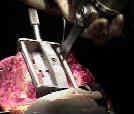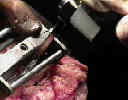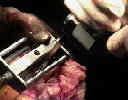 - Theoretical Considerations:
- Theoretical Considerations: - distance from posterior reesction plane to anterior resection plane must equal the internal dimension of femoral component being used;
- this cut must be made at a distance from the anterior cut equal to inner anterior-posterior dimension of femoral component used;
- depending upon inner geometry of implant being used, anterior and posterior resection lines should either be parallel or diverge slightly;
- flexion gap:
- should be rectangular in shape rather than trapezoidal, in order to achieve this, femoral template is externally rotated on distal femur until
it become parallel with the cut tibia surface;
- this results in more bone resection from the posterior medial femoral condyle than the posterior lateral femoral condyle;
- amount of posterior femoral condylar bone removed should equal thickness of posterior condylar dismension of implant being used;
- rotatory alignment of cutting guide:
- rotatory alignament of the AP cutting jig is normally based upon the position of the posterior femoral condyle;
- in some of the older TKR designs, it was recommended that the tibia be cut in slight varus (to reproduce the anatomy);
- w/ this type of design, it is necessary to remove an equal amount of bone should be removed from each posterior femoral condyle;
- this type of design does not allow for external rotation of the femoral component (since this would created a trapezoidal shaped flexion gap), and this has a negative effect on patellar tracting;
- newer TKR designs recommend that the proximal tibia be cut at 90 deg (as opposed to 3 deg of varus), and therefore it is necessary to
make the AP cuts in 3 deg of external rotation in order to keep a rectangular flexion gap;
- this slight external rotation has a beneficial effect on patellar rotation;
- when the tibia has been resected at 90 deg, however, slightly more bone must be removed from the medial than from lateral
condyle (that is guide must be slightly externally rotated) in order to reestablish rectangularity of flexion space;
- femoral template should not be internally rotated, since this moves patellofemoral groove of femoral component medially, making it more difficult for laterally placed patella to capture groove;
- malrotation of the femoral component may lead to patellar dislocation or subluxation;
- Technique:
- proper size of the AP and Chamfer cuts is confirmed w/ the AP sizing guide;
- rotational alignment of the cutting guide:
- when the posterior femoral condyles have been eroded, ensure that the cutting device is perpendicular to the femoral trochlea;
- always ensure that the anterior cut will not notch the femoral cortex;
- cutting block is placed & anterior, posterior, & chamfer cuts performed w/ retractors placed to protect collateral ligaments, and the patellar tendon;
- bone is removed & cuts rechecked and noted to be intact;
- visualization: ensure that the block is properly seated;
- because the surgeon stands on the lateral side of the operative knee, optimal seating of the medial end of the block will not be easily
visualized without a concentrated effort;
- pitfalls:
- femoral component notching
- avoid femoral component extension (in saggital plane)
- inaccurate sagittal orientation that places femoral component in too much extension may notch the anterior femur and can
lead to later supracondylar fracture of the femur;
- starting hole needs to be posterior and medial to avoid notching;
- saw blade is initially angled upwards;
- damaged jig alignment lugs
- note that the alignment lugs of the cutting guide will often screw into the jig;
- because of cross thread damage and "wear and tear trauma", the lugs may become malaligned to the main jig body;
- consequence is that the lugs may keep the main jig body angled away from the distal femoral surface - leading to cutting error;

- femoral component placed in too much flexion alters the kinematics of the knee and may decrease extension;
- be aware that the saw blade needs to be appropriate for the company specific jig (a saw blade that is too
thin can notch the femur despite accurate jig positioning);
- incomplete cuts
- if any part of the AP & chamfer cuts remains incomplete then the subsequent box cutting jig will not properly seat down, and the
final componenents will not completly seat down;
- Resection of the Anterior Femur: (see femoral component notching)
- size of the component must be chosen so that the anterior resection does not notch femoral cortex;
- such inadvertent notching can set up a stress riser in femur w/ the potential of later frx;
- this cut intersects the femoral cortex at the point where the trochlear surface merges into the shaft;
- any resection posterior to this point will notch anterior femur;
- always aim the saw blade upwards during the cut to minimize the tendency for the saw to bend posteriorly;
- Resection of the Posterior Femur:
- the medial condyle extends below the epicondylar axis further than the lateral condyle and therefore, more of the medial condyle will be resected;
- if a PCL retaining component is to be used, consider using a narrow blade saw so that there will be less chance of injuring the PCL;
- maximal flexion of the knee will help protect the posterior N/V bundle;
- after the sawing is complete, small remnant portions of uncut bone may hold the posterior fragment to the femur;
- pass a 1 inch straight osteotome into the saw cut and gently tap it until the posterior fragment is freed;
- Chamfer Cuts:
- Trial Femoral Components:
- trial femoral component (or box cutting jig) are placed at this point;
- if the trial does not sit down perfectly, then the cuts need to be repeated;
- take the knee thru flexion and extension and note the propensity for patellar subluxation;
- if there is a tendency for lateral subluxation, then the trial should be slightly lateralized;
- even slight medialization of the femoral component can cause tightening of the lateral retinaculum leading to patellar maltracking;
- even if a posterior stabilized prosthesis is going to be used, insert the PCL retaining trial component at this step, since it is more efficient
to recut the distal femur at this point than to have to do it once the box cuts have been completed;
- Box Cuts: (for Posterior Stabilized Componenets)
Effect of a cooled saw blade on prosthesis fixation. Randomized radiostereometry of 33 knee cases.
On the problem of heat generation in bone cutting. Studies on the effects on liquid cooling.
The effect of prosthetic patellar thickness and anterior femoral surface on limiting flexion in TKR. Holtgrew J, et al. In: Trans of 35th Annu Meet Orthop Res Soc. 1989;14:369











